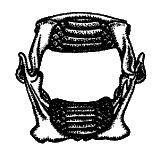Batoids: Order Myliobatiformes:
Stingrays — 178 species

- pectoral disc rhomboid, oval, or triangular in outline, elaborated into gracefully-shaped wings in some forms
- tail moderately stout to very slender
- caudal fin and a single dorsal fin are variably present or absent, depending on species
- most species have one or more saw-edged spines or stings on the dorsal surface of the tail (the sting is a modified dermal denticle, sheathed with poisonous tissue and used as a defensive weapon)
- most forms have five pairs of gill slits, but members of the family Hexatrygonidae have six
- ovoviviparous
- temperate to tropical zones of the Atlantic, Pacific, and Indian oceans; most species are marine, but some enter brackish or fresh waters and the river stingrays (family Potamotrygonidae) are exclusively freshwater inhabitants, having lost the ability to osmoregulate in the sea
- 33 genera in 10 families
|
|
Myliobatiform rays include some of the largest and most notorious batoids. The spectacular Manta Ray (Manta birostris) is an enormous filter-feeder, with a wingspan measuring up to 22 feet (6.7 metres). Mantas and the related devil rays (Mobula sp.) have paddle-like 'cepahalic fins' which may help funnel planktonic prey into the large, squarish mouth. The tiny food is strained from the seawater by means of plates of spongy tissue inside the gill chamber. Most stingrays are bottom-dwellers that specialize in feeding on buried molluscs and crustaceans, but the Pelagic Stingray (Pteroplatytrygon violacea) is fully pelagic, feeding primarily on open-ocean squids.
Internationally famous Stingray City, off Grand Cayman, has been called "the most exciting 12-foot dive in the world". Many thousands of divers have fed and handled the resident Southern Stingrays (this species is widely known as Dasyatis americana, but that name may be a junior synonym of Amphotistius longus) without serious incident. While a few divers have had their hands or arms 'bitten', the flattened dental plates of this species do minimal damage (often little more than a reddish pucker-mark called a "stingray hickey"). Although the rays at Stingray City are largely habituated to contact with people, there has been at least one serious injury inflicted by a stingray on a diver at this location. Each year, some 1,500 stingray-related injuries are recorded in the United States (mostly minor puncture wounds around the feet and ankles), the vast majority of which are due more to human carelessness than aggression on the part of these rays. The danger posed by stingrays is often exaggerated, as they use their stinging spines only in self-defense, but their venomous nature is very real. World-wide, several stingray-related fatalities are recorded every year — as sometimes occurs when a diver swims too close over a partially buried ray and is stung in the neck or chest.

The tail spines of a Southern Stingray (Dasyatis americana = Amphotistius longus?) are actually highly modified dermal denticles. Each spine features a spongy core of venom-producing tissue and an enameloid covering with serrations pointing toward the base, a feature that renders removal difficult and painful. Like other dermal denticles, these stinging spines are replaced continually. Most stingray species have two such spines, each originating from its own locus and with its own cycle of development, eruption, growth, shedding, and replacement. Replacement spines usually alternate between loci, staggered by about half a cycle, so that one spine (the older) is typically larger and more worn than the other. As part of their growth cycle, old, worn spines fall out and are eventually replaced by new, sharp ones; replacement spines at a given locus grow in alternately above and below their immediate predecessor. This squamous choreography is sometimes less-than-perfect, the new spine erupting before the old has fallen out. It is thus not uncommon to find stingrays with several spines bristling from both loci on the tail, an arrangement which resembles a Swiss army knife with all its blades splayed out.
|
|
The eagle, duckbilled and cownose rays (subfamilies Myliobatinae, Aetobatinae, and Rhinopterinae, respectively) are 'nutcracker rays', their teeth fused into elaborate plates which they use to crush hard-shelled prey.
Mother myliobatoids secrete a protein-rich histotroph ('uterine milk') to provide fetal nourishment before birth; in some forms, gestatory parts of the uterus form thousands of long nutritive threads (trophonemata) that enter the developing rays through the spiracles, thus delivering their nourishing secretions directly into the pharyx.
In 1990, Kiyonori Nishida presented a major revision of the myliobatoid rays (which he considered a batoid suborder). The taxonomic scheme adopted here differs from Nishida's most notably in including the families Platyrhinidae and Zanobatidae within the Myliobatiformes (after McEachran 1996), rather than following the tradition of regarding them as odd guitarfishes. As a group, the myliobatiform rays are regarded as the most derived ('advanced') of batoids.
 Named for the way underwater sunlight shimmers
from the dermal denticles studding their yellowish-brown skin, these
Golden Cownose Ray (Rhinoptera steindachneri) were photographed off
the Galapagos Islands. This species seasonally gathers in large
schools that are probably associated with Golden Cownose Ray courtship.
Named for the way underwater sunlight shimmers
from the dermal denticles studding their yellowish-brown skin, these
Golden Cownose Ray (Rhinoptera steindachneri) were photographed off
the Galapagos Islands. This species seasonally gathers in large
schools that are probably associated with Golden Cownose Ray courtship.
Photo © David Fleetham david@davidfleetham.com; used with the gracious permission of the photographer.


